stop start PONTIAC GRAND PRIX 2007 Owners Manual
[x] Cancel search | Manufacturer: PONTIAC, Model Year: 2007, Model line: GRAND PRIX, Model: PONTIAC GRAND PRIX 2007Pages: 526, PDF Size: 2.92 MB
Page 10 of 526

Heated Seats
If the vehicle has this
feature, the buttons are
located on the climate
control panel. See
Climate Control System
on page 157for
more information.
Press the button once to activate the high heat
setting. Both indicator lights next to the button will
come on.
Press the button again to select the lower
temperature setting. Only the bottom indicator light
will come on.
Press the button a third time to turn the heat off.
This feature only works when the ignition is on.
Reclining Seatbacks
{CAUTION:
You can lose control of the vehicle if you
try to adjust a manual driver’s seat while
the vehicle is moving. The sudden
movement could startle and confuse you,
or make you push a pedal when you do
not want to. Adjust the driver’s seat only
when the vehicle is not moving.
{CAUTION:
If the seatback is not locked, it could
move forward in a sudden stop or crash.
That could cause injury to the person
sitting there. Always push and pull on the
seatback to be sure it is locked.
10
Page 103 of 526
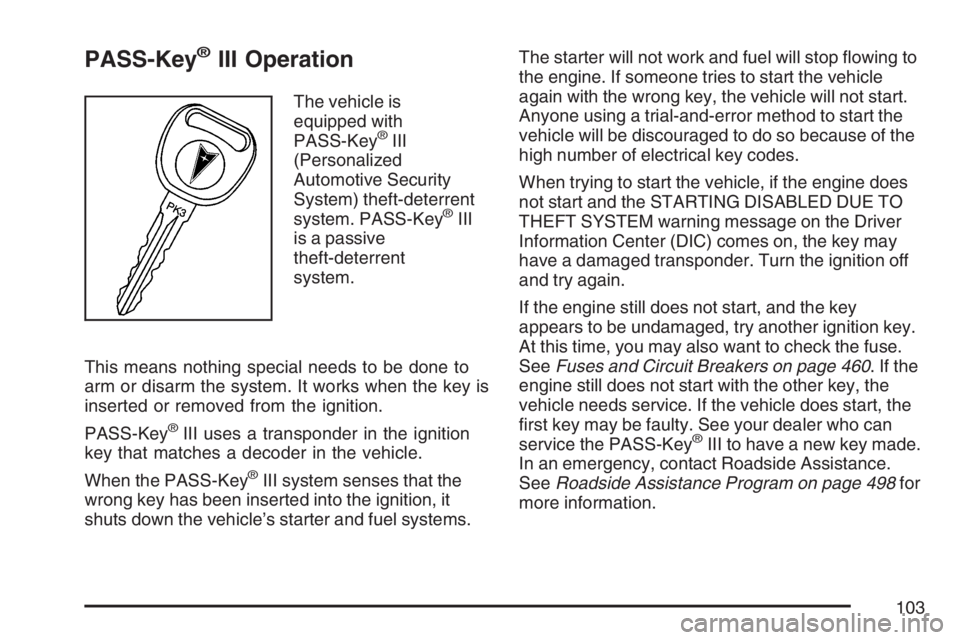
PASS-Key®III Operation
The vehicle is
equipped with
PASS-Key
®III
(Personalized
Automotive Security
System) theft-deterrent
system. PASS-Key
®III
is a passive
theft-deterrent
system.
This means nothing special needs to be done to
arm or disarm the system. It works when the key is
inserted or removed from the ignition.
PASS-Key
®III uses a transponder in the ignition
key that matches a decoder in the vehicle.
When the PASS-Key
®III system senses that the
wrong key has been inserted into the ignition, it
shuts down the vehicle’s starter and fuel systems.The starter will not work and fuel will stop �owing to
the engine. If someone tries to start the vehicle
again with the wrong key, the vehicle will not start.
Anyone using a trial-and-error method to start the
vehicle will be discouraged to do so because of the
high number of electrical key codes.
When trying to start the vehicle, if the engine does
not start and the STARTING DISABLED DUE TO
THEFT SYSTEM warning message on the Driver
Information Center (DIC) comes on, the key may
have a damaged transponder. Turn the ignition off
and try again.
If the engine still does not start, and the key
appears to be undamaged, try another ignition key.
At this time, you may also want to check the fuse.
SeeFuses and Circuit Breakers on page 460.Ifthe
engine still does not start with the other key, the
vehicle needs service. If the vehicle does start, the
�rst key may be faulty. See your dealer who can
service the PASS-Key
®III to have a new key made.
In an emergency, contact Roadside Assistance.
SeeRoadside Assistance Program on page 498for
more information.
103
Page 105 of 526
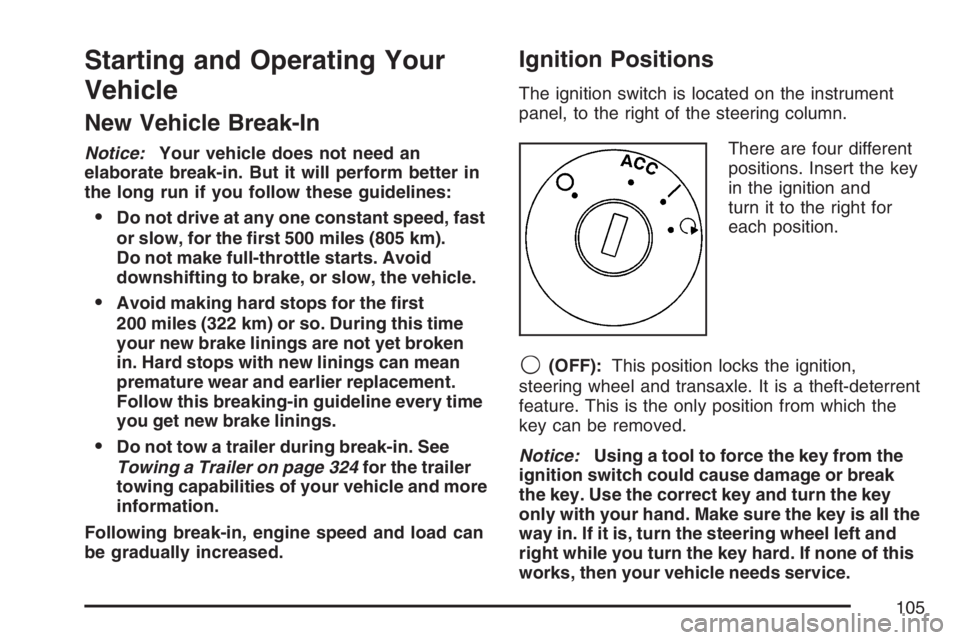
Starting and Operating Your
Vehicle
New Vehicle Break-In
Notice:Your vehicle does not need an
elaborate break-in. But it will perform better in
the long run if you follow these guidelines:
Do not drive at any one constant speed, fast
or slow, for the �rst 500 miles (805 km).
Do not make full-throttle starts. Avoid
downshifting to brake, or slow, the vehicle.
Avoid making hard stops for the �rst
200 miles (322 km) or so. During this time
your new brake linings are not yet broken
in. Hard stops with new linings can mean
premature wear and earlier replacement.
Follow this breaking-in guideline every time
you get new brake linings.
Do not tow a trailer during break-in. See
Towing a Trailer on page 324for the trailer
towing capabilities of your vehicle and more
information.
Following break-in, engine speed and load can
be gradually increased.
Ignition Positions
The ignition switch is located on the instrument
panel, to the right of the steering column.
There are four different
positions. Insert the key
in the ignition and
turn it to the right for
each position.
9(OFF):This position locks the ignition,
steering wheel and transaxle. It is a theft-deterrent
feature. This is the only position from which the
key can be removed.
Notice:Using a tool to force the key from the
ignition switch could cause damage or break
the key. Use the correct key and turn the key
only with your hand. Make sure the key is all the
way in. If it is, turn the steering wheel left and
right while you turn the key hard. If none of this
works, then your vehicle needs service.
105
Page 107 of 526

Starting the Engine
Place the transaxle in the proper gear.
Move your shift lever to PARK (P) or
NEUTRAL (N). Your engine will not start in
any other position — this is a safety feature.
To restart when you are already moving,
use NEUTRAL (N) only.
Notice:Shifting into PARK (P) with the vehicle
moving could damage the transaxle. Shift into
PARK (P) only when your vehicle is stopped.
Starting Procedure
1. With your foot off the accelerator pedal, turn
the ignition key to START. When the engine
starts, let go of the key. The idle speed will go
down as your engine gets warm. Do not
race the engine immediately after starting it.
Operate the engine and transaxle gently
to allow the oil to warm up and lubricate all
moving parts.Your vehicle has a Computer-Controlled
Cranking System. This feature assists in
starting the engine and protects components.
If the ignition key is turned to the START
position, and then released when the engine
begins cranking, the engine will continue
cranking for a few seconds or until the vehicle
starts. If the engine does not start and the
key is held in START for many seconds,
cranking will be stopped after 15 seconds to
prevent cranking motor damage. To prevent
gear damage, this system also prevents
cranking if the engine is already running.
Engine cranking can be stopped by turning the
ignition switch to the ACC or OFF position.
Notice:Cranking the engine for long periods
of time, by returning the key to the START
position immediately after cranking has ended,
can overheat and damage the cranking
motor, and drain the battery. Wait at least
15 seconds between each try, to allow
the cranking motor to cool down.
107
Page 108 of 526

2. If the engine does not start after 5-10 seconds,
especially in very cold weather (below 0°F
or−18°C), it could be �ooded with too much
gasoline. Try pushing the accelerator
pedal all the way to the �oor and holding it
there as you hold the key in START for up to
a maximum of 15 seconds. Wait at least
15 seconds between each try, to allow the
cranking motor to cool down. When the engine
starts, let go of the key and accelerator. If
the vehicle starts brie�y but then stops again,
do the same thing. This clears the extra
gasoline from the engine. Do not race the
engine immediately after starting it. Operate
the engine and transaxle gently until the
oil warms up and lubricates all moving parts.
Notice:Your engine is designed to work with
the electronics in your vehicle. If you add
electrical parts or accessories, you could
change the way the engine operates. Before
adding electrical equipment, check with
your dealer. If you do not, your engine might
not perform properly. Any resulting damage
would not be covered by your vehicle’s
warranty.Engine Coolant Heater
The vehicle may be equipped with an engine
coolant heater. In very cold weather, 0°F (−18°C)
or colder, the engine coolant heater can help.
The vehicle will start easier and get better
fuel economy during engine warm-up. Usually, the
coolant heater should be plugged in a minimum
of four hours prior to starting the vehicle. At
temperatures above 32°F (0°C), use of the coolant
heater is not required. Your vehicle may also
have an internal thermostat in the plug end of the
cord. This will prevent operation of the engine
coolant heater when the temperature is at or above
0°F (−18°C) as noted on the cord.
108
Page 109 of 526
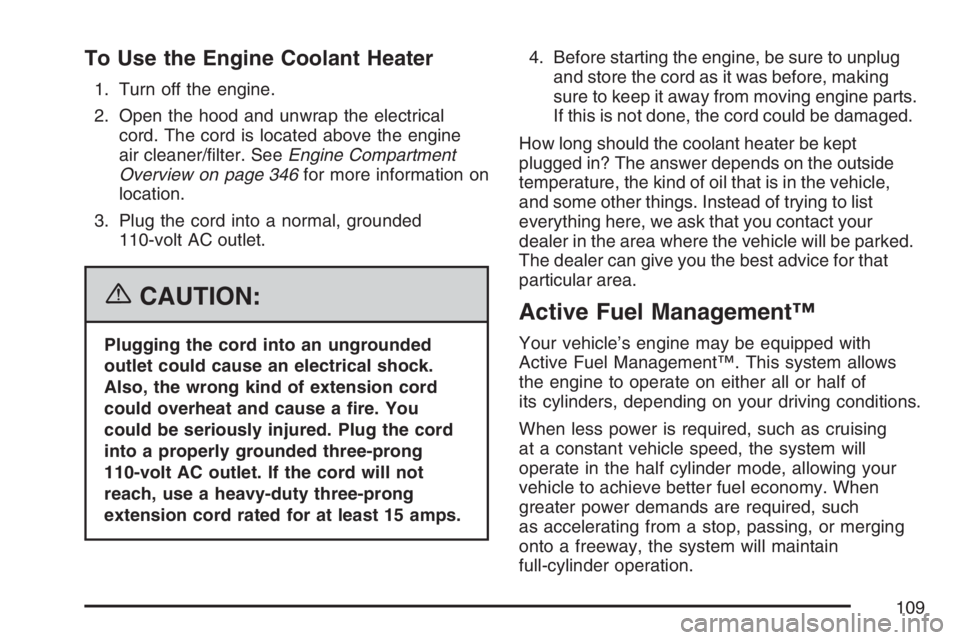
To Use the Engine Coolant Heater
1. Turn off the engine.
2. Open the hood and unwrap the electrical
cord. The cord is located above the engine
air cleaner/�lter. SeeEngine Compartment
Overview on page 346for more information on
location.
3. Plug the cord into a normal, grounded
110-volt AC outlet.
{CAUTION:
Plugging the cord into an ungrounded
outlet could cause an electrical shock.
Also, the wrong kind of extension cord
could overheat and cause a �re. You
could be seriously injured. Plug the cord
into a properly grounded three-prong
110-volt AC outlet. If the cord will not
reach, use a heavy-duty three-prong
extension cord rated for at least 15 amps.4. Before starting the engine, be sure to unplug
and store the cord as it was before, making
sure to keep it away from moving engine parts.
If this is not done, the cord could be damaged.
How long should the coolant heater be kept
plugged in? The answer depends on the outside
temperature, the kind of oil that is in the vehicle,
and some other things. Instead of trying to list
everything here, we ask that you contact your
dealer in the area where the vehicle will be parked.
The dealer can give you the best advice for that
particular area.
Active Fuel Management™
Your vehicle’s engine may be equipped with
Active Fuel Management™. This system allows
the engine to operate on either all or half of
its cylinders, depending on your driving conditions.
When less power is required, such as cruising
at a constant vehicle speed, the system will
operate in the half cylinder mode, allowing your
vehicle to achieve better fuel economy. When
greater power demands are required, such
as accelerating from a stop, passing, or merging
onto a freeway, the system will maintain
full-cylinder operation.
109
Page 111 of 526

Make sure the shift lever is fully in PARK (P)
before starting the engine. The vehicle has
an automatic transaxle shift lock control system.
You must fully apply your regular brakes �rst
and then press the shift lever button, located on
the front of the shift lever, before you can shift from
PARK (P) when the ignition key is in RUN.
If the vehicle cannot be shifted out of PARK (P),
ease pressure on the shift lever by pushing it
all the way into PARK (P) as you maintain brake
application. Then press the shift lever button
and move the shift lever into another gear.
SeeShifting Out of Park (P) on page 117.
REVERSE (R):Use this gear to back up.
Notice:Shifting to REVERSE (R) while your
vehicle is moving forward could damage
the transaxle. The repairs would not be
covered by your warranty. Shift to
REVERSE (R) only after your vehicle is
stopped.
To rock the vehicle back and forth to get out of
snow, ice or sand without damaging the transaxle,
seeIf Your Vehicle is Stuck in Sand, Mud, Ice,
or Snow on page 316.NEUTRAL (N):In this position, the engine does
not connect with the wheels. To restart when
the vehicle is already moving, use NEUTRAL (N)
only. Also, use NEUTRAL (N) when the vehicle
is being towed.
{CAUTION:
Shifting into a drive gear while your
engine is running at high speed is
dangerous. Unless your foot is �rmly on
the brake pedal, your vehicle could move
very rapidly. You could lose control and
hit people or objects. Do not shift into a
drive gear while your engine is running at
high speed.
Notice:Shifting out of PARK (P) or
NEUTRAL (N) while the engine is running at
high speed may damage the transaxle.
The repairs would not be covered by your
warranty. Be sure the engine is not running at
high speeds when shifting your vehicle.
111
Page 114 of 526
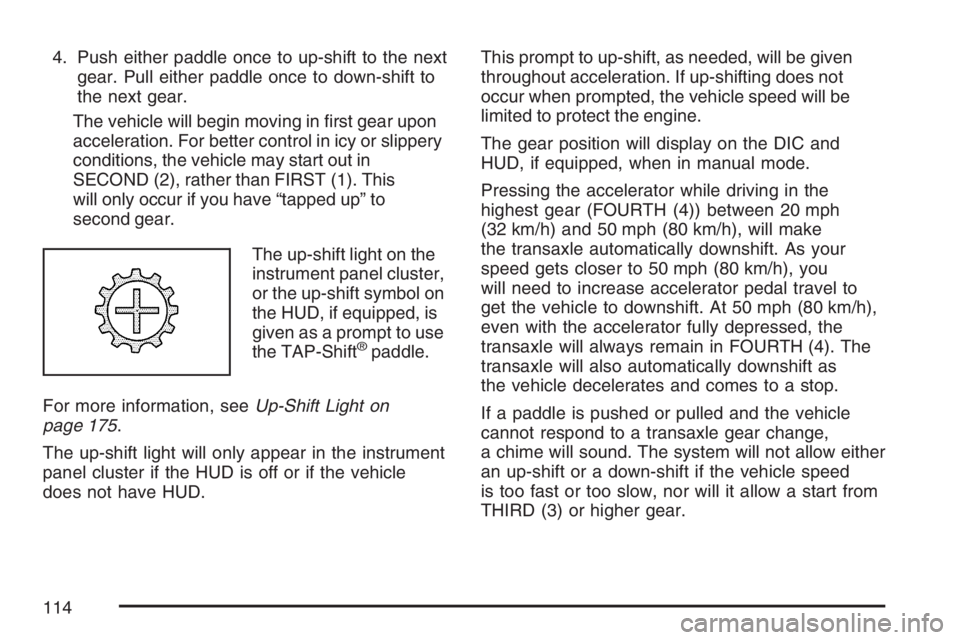
4. Push either paddle once to up-shift to the next
gear. Pull either paddle once to down-shift to
the next gear.
The vehicle will begin moving in �rst gear upon
acceleration. For better control in icy or slippery
conditions, the vehicle may start out in
SECOND (2), rather than FIRST (1). This
will only occur if you have “tapped up” to
second gear.
The up-shift light on the
instrument panel cluster,
or the up-shift symbol on
the HUD, if equipped, is
given as a prompt to use
the TAP-Shift
®paddle.
For more information, seeUp-Shift Light on
page 175.
The up-shift light will only appear in the instrument
panel cluster if the HUD is off or if the vehicle
does not have HUD.This prompt to up-shift, as needed, will be given
throughout acceleration. If up-shifting does not
occur when prompted, the vehicle speed will be
limited to protect the engine.
The gear position will display on the DIC and
HUD, if equipped, when in manual mode.
Pressing the accelerator while driving in the
highest gear (FOURTH (4)) between 20 mph
(32 km/h) and 50 mph (80 km/h), will make
the transaxle automatically downshift. As your
speed gets closer to 50 mph (80 km/h), you
will need to increase accelerator pedal travel to
get the vehicle to downshift. At 50 mph (80 km/h),
even with the accelerator fully depressed, the
transaxle will always remain in FOURTH (4). The
transaxle will also automatically downshift as
the vehicle decelerates and comes to a stop.
If a paddle is pushed or pulled and the vehicle
cannot respond to a transaxle gear change,
a chime will sound. The system will not allow either
an up-shift or a down-shift if the vehicle speed
is too fast or too slow, nor will it allow a start from
THIRD (3) or higher gear.
114
Page 136 of 526
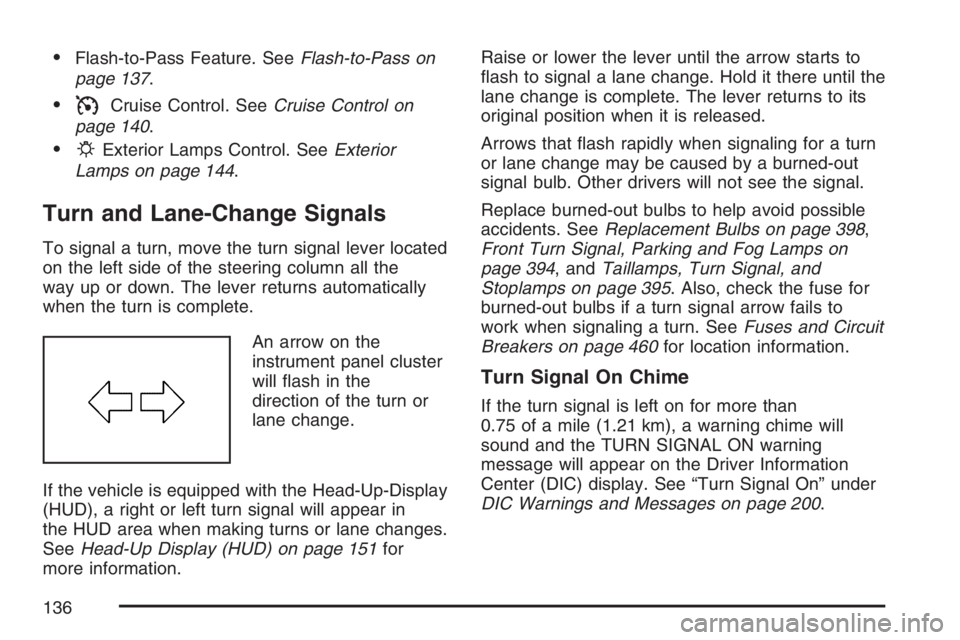
Flash-to-Pass Feature. SeeFlash-to-Pass on
page 137.
ICruise Control. SeeCruise Control on
page 140.
PExterior Lamps Control. SeeExterior
Lamps on page 144.
Turn and Lane-Change Signals
To signal a turn, move the turn signal lever located
on the left side of the steering column all the
way up or down. The lever returns automatically
when the turn is complete.
An arrow on the
instrument panel cluster
will �ash in the
direction of the turn or
lane change.
If the vehicle is equipped with the Head-Up-Display
(HUD), a right or left turn signal will appear in
the HUD area when making turns or lane changes.
SeeHead-Up Display (HUD) on page 151for
more information.Raise or lower the lever until the arrow starts to
�ash to signal a lane change. Hold it there until the
lane change is complete. The lever returns to its
original position when it is released.
Arrows that �ash rapidly when signaling for a turn
or lane change may be caused by a burned-out
signal bulb. Other drivers will not see the signal.
Replace burned-out bulbs to help avoid possible
accidents. SeeReplacement Bulbs on page 398,
Front Turn Signal, Parking and Fog Lamps on
page 394, andTaillamps, Turn Signal, and
Stoplamps on page 395. Also, check the fuse for
burned-out bulbs if a turn signal arrow fails to
work when signaling a turn. SeeFuses and Circuit
Breakers on page 460for location information.
Turn Signal On Chime
If the turn signal is left on for more than
0.75 of a mile (1.21 km), a warning chime will
sound and the TURN SIGNAL ON warning
message will appear on the Driver Information
Center (DIC) display. See “Turn Signal On” under
DIC Warnings and Messages on page 200.
136
Page 177 of 526
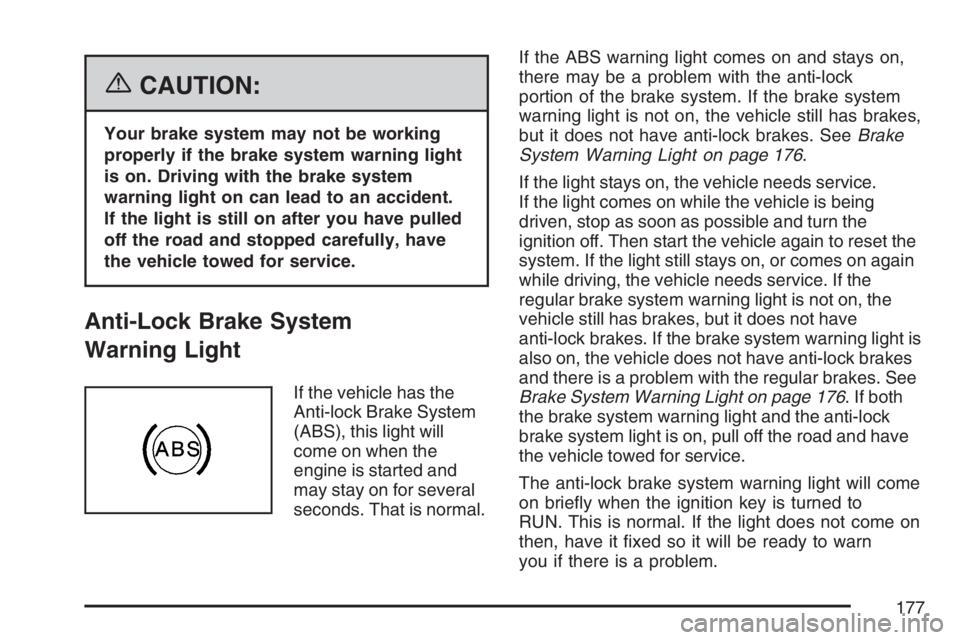
{CAUTION:
Your brake system may not be working
properly if the brake system warning light
is on. Driving with the brake system
warning light on can lead to an accident.
If the light is still on after you have pulled
off the road and stopped carefully, have
the vehicle towed for service.
Anti-Lock Brake System
Warning Light
If the vehicle has the
Anti-lock Brake System
(ABS), this light will
come on when the
engine is started and
may stay on for several
seconds. That is normal.If the ABS warning light comes on and stays on,
there may be a problem with the anti-lock
portion of the brake system. If the brake system
warning light is not on, the vehicle still has brakes,
but it does not have anti-lock brakes. SeeBrake
System Warning Light on page 176.
If the light stays on, the vehicle needs service.
If the light comes on while the vehicle is being
driven, stop as soon as possible and turn the
ignition off. Then start the vehicle again to reset the
system. If the light still stays on, or comes on again
while driving, the vehicle needs service. If the
regular brake system warning light is not on, the
vehicle still has brakes, but it does not have
anti-lock brakes. If the brake system warning light is
also on, the vehicle does not have anti-lock brakes
and there is a problem with the regular brakes. See
Brake System Warning Light on page 176. If both
the brake system warning light and the anti-lock
brake system light is on, pull off the road and have
the vehicle towed for service.
The anti-lock brake system warning light will come
on brie�y when the ignition key is turned to
RUN. This is normal. If the light does not come on
then, have it �xed so it will be ready to warn
you if there is a problem.
177